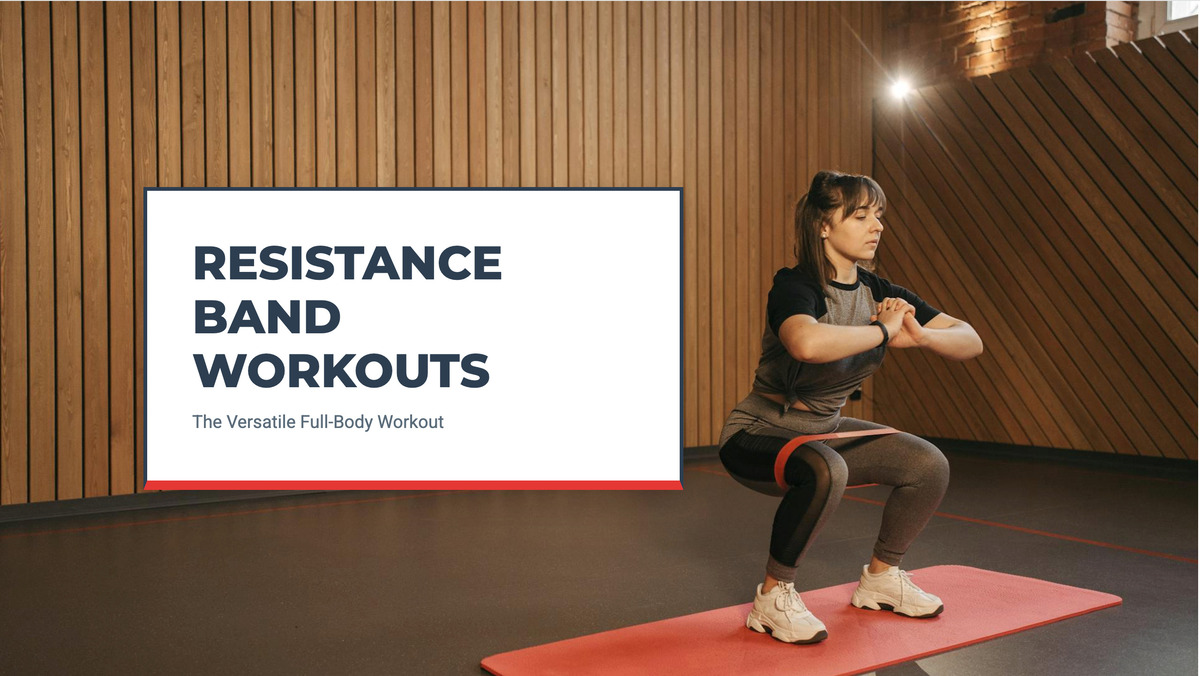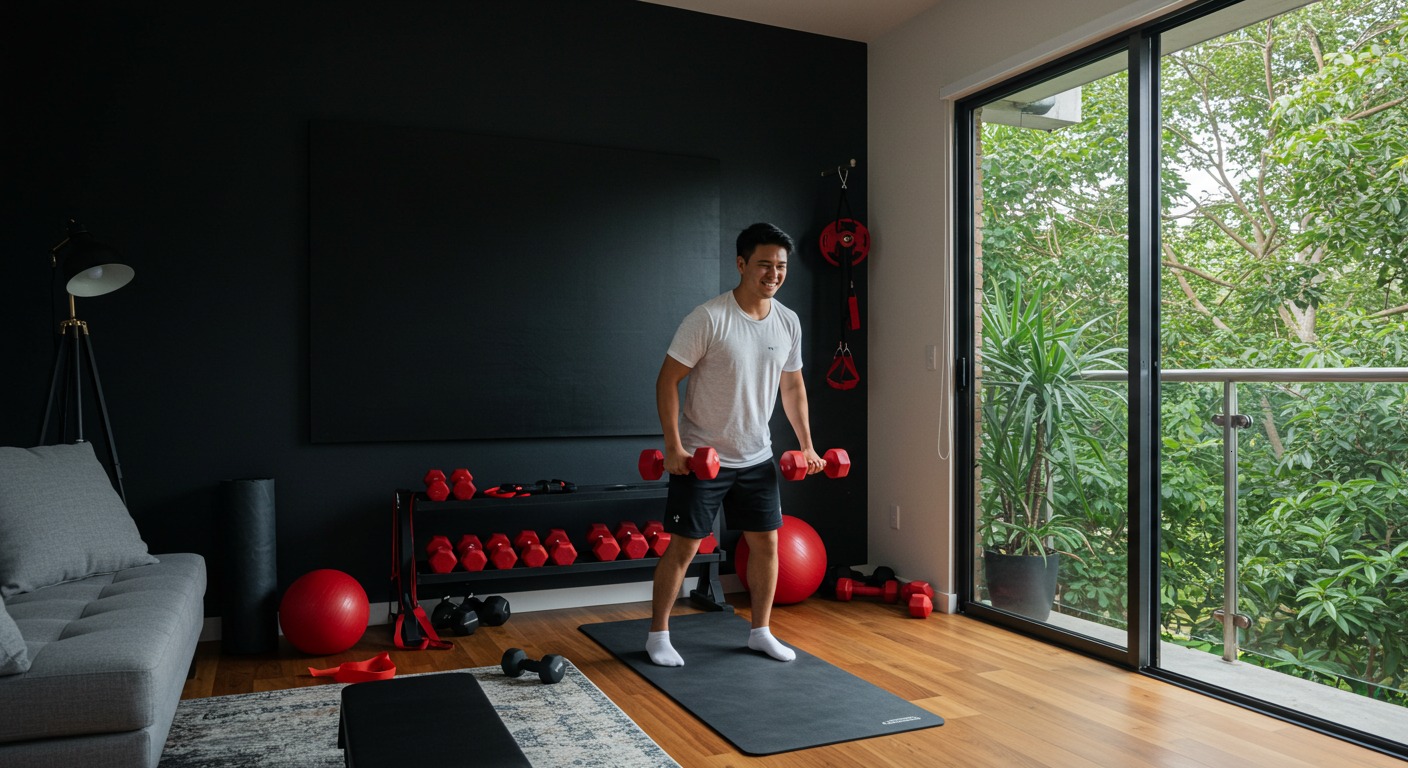Disclosure Information
This blog contains affiliate links. If you make a purchase through one of these links, our team may earn a commission at no extra cost to you. Learn more. Thanks for your support!
Home fitness has revolutionized how we approach exercise, eliminating barriers and making workouts accessible to everyone. Among the most versatile and effective tools in your home gym arsenal are resistance bands.
These simple yet powerful pieces of equipment offer countless possibilities for building strength, improving flexibility, and enhancing overall fitness.
Whether you’re a beginner starting your fitness journey or an experienced athlete looking to diversify your routine, resistance bands provide exceptional value and results.
Why Resistance Bands Are Perfect for Home Workouts
Resistance bands deliver constant tension throughout the entire range of motion, unlike traditional weights that rely on gravity. This unique characteristic makes them incredibly effective for muscle activation and strength building.
The portability factor sets resistance bands apart from other fitness equipment. You can easily store them in a drawer, take them while traveling, or use them in any room of your house.
According to a study published in the Journal of Strength and Conditioning Research, resistance band training produces similar strength gains to traditional weight training while being significantly more convenient for home use (source: Journal of Strength and Conditioning Research).
Cost-effectiveness makes resistance bands an attractive option for budget-conscious fitness enthusiasts. A complete set of resistance bands typically costs less than a single month’s gym membership while providing years of reliable service.
Types of Resistance Bands for Home Exercise
Loop Bands
Loop bands, also known as mini bands, are small circular bands perfect for targeting specific muscle groups. They excel at activation exercises and lower body workouts, particularly for glutes and hip stabilizers.
These bands come in various resistance levels, typically color-coded for easy identification. Light resistance works well for warm-ups and rehabilitation, while heavy resistance challenges even advanced users.
Tube Bands with Handles
Tube bands feature comfortable handles and often include door anchors for versatile workout options. They’re excellent for upper body exercises and can easily replicate gym machine movements.
The adjustable nature of tube bands allows you to modify resistance by changing your grip position. This adaptability makes them suitable for progressive overload and various fitness levels.
Flat Bands
Flat bands offer the most versatility in terms of grip options and exercise variations. They’re particularly effective for stretching, rehabilitation, and full-body workouts.
Physical therapists frequently recommend flat bands for injury prevention and recovery. Their gentle resistance makes them ideal for older adults or those with joint concerns.
Essential Equipment and Setup
Choosing the Right Resistance Level
Selecting appropriate resistance levels is crucial for effective workouts and injury prevention. Most manufacturers use color-coding systems to indicate resistance levels, though these can vary between brands.
Start with lighter resistance to master proper form before progressing to heavier bands. Having multiple resistance levels allows you to target different muscle groups effectively and progress over time.
Door Anchor Systems
Door anchors expand your exercise possibilities by creating multiple anchor points at different heights. Ensure your door is sturdy and properly hung before using anchor systems.
Position the anchor at various heights to target muscles from different angles. High anchor points work well for lat pulldowns, while low positions are perfect for rows and bicep curls.
Safety Considerations
Always inspect your bands before each workout session, looking for cuts, nicks, or signs of wear. Replace damaged bands immediately to prevent injury from sudden snapping.
Maintain proper form throughout all exercises to maximize benefits and minimize injury risk. Focus on controlled movements rather than speed or excessive resistance.
Upper Body Resistance Band Exercises
Chest and Shoulder Exercises
Chest Press Position yourself facing away from the door anchor with bands at chest height. Step forward to create tension, then press handles forward while keeping your core engaged.
Control the return movement slowly to maximize muscle engagement. Adjust resistance by stepping closer to or farther from the anchor point.
Shoulder Press Stand on the center of the band with feet shoulder-width apart. Raise handles to shoulder height, then press directly overhead while maintaining proper posture.
Keep your core tight throughout the movement to protect your lower back. Lower the handles slowly to shoulder level before repeating.
Lateral Raises Stand in the center of the band with slight tension in the starting position. Raise your arms out to the sides until they’re parallel to the floor.
Focus on initiating the movement from your shoulders rather than your arms. Control the descent to maximize muscle activation.
Back and Arm Exercises
Seated Row Sit with legs extended and the band wrapped around your feet. Pull the handles toward your torso while squeezing your shoulder blades together.
Maintain an upright posture throughout the movement. Focus on pulling with your back muscles rather than your arms.
Lat Pulldown Secure the band at a high anchor point and kneel facing the anchor. Pull the handles down and slightly back while engaging your latissimus dorsi muscles.
Keep your chest up and shoulders back throughout the movement. Control the return to starting position.
Bicep Curls Stand on the band with feet hip-width apart. Curl the handles toward your shoulders while keeping your elbows stationary at your sides.
Squeeze your biceps at the top of the movement before lowering slowly. Avoid swinging or using momentum.
Tricep Extensions Secure the band at a high anchor point and face away from the anchor. Extend your arms downward while keeping your elbows close to your sides.
Focus on the tricep muscles throughout the movement. Return to starting position with control.
Lower Body Resistance Band Exercises
Glute and Hip Exercises
Glute Bridges Lie on your back with a loop band around your thighs, just above your knees. Lift your hips while pressing your knees outward against the band’s resistance.
Squeeze your glutes at the top position before lowering slowly. Keep your core engaged throughout the movement.
Clamshells Lie on your side with the band around your thighs. Keeping your feet together, lift your top knee while maintaining hip alignment.
Focus on using your glute muscles to create the movement. Control both the lifting and lowering phases.
Monster Walks Place a loop band around your ankles and assume a semi-squat position. Step laterally while maintaining tension in the band.
Keep your knees aligned over your toes throughout the movement. Maintain the squat position for added core engagement.
Leg Exercises
Squats Stand on the band with feet shoulder-width apart, handles at shoulder height. Lower into a squat position while maintaining upward pressure on the handles.
Keep your weight in your heels and your knees tracking over your toes. Press through your heels to return to standing.
Lunges Step back into a lunge position with the band under your front foot. Hold the handles at shoulder height and perform lunges while maintaining band tension.
Keep your front knee over your ankle and your torso upright. Push through your front heel to return to starting position.
Deadlifts Stand on the band with feet hip-width apart. Hinge at your hips while keeping the band taut and your back straight.
Focus on pushing your hips back rather than bending your knees. Drive through your heels to return to standing.
Core and Stability Exercises
Rotational Movements
Wood Chops Secure the band at chest height and stand perpendicular to the anchor point. Pull the handle across your body in a diagonal chopping motion.
Engage your core throughout the movement while allowing your torso to rotate naturally. Control the return to starting position.
Russian Twists Sit with knees bent and the band anchored behind you. Rotate your torso from side to side while maintaining tension in the band.
Keep your chest up and core engaged throughout the movement. Focus on rotating from your core rather than your arms.
Stability Challenges
Plank with Band Pull-Aparts Hold a plank position while gripping a resistance band. Pull the band apart while maintaining proper plank form.
Focus on keeping your hips level and your core tight. Perform the arm movement slowly and controlled.
Dead Bug Lie on your back with the band around your hands held above your chest. Extend opposite arm and leg while maintaining band tension.
Keep your lower back pressed against the floor throughout the movement. Return to starting position with control.
Full-Body Resistance Band Workouts
Beginner Workout Routine
A well-structured beginner routine should focus on mastering basic movement patterns while building foundational strength. Research shows that beginners can achieve significant strength gains with just 2-3 resistance training sessions per week (source: American College of Sports Medicine).
Workout Structure:
- Warm-up: 5-10 minutes of light band exercises
- Main workout: 3 sets of 12-15 repetitions
- Cool-down: 5-10 minutes of stretching with bands
Perform this routine 2-3 times per week with at least one rest day between sessions. Focus on proper form over speed or resistance level.
Intermediate Workout Routine
Intermediate users can handle more complex movement patterns and increased training frequency. This routine incorporates compound movements and higher training volumes.
Workout Structure:
- Warm-up: 10 minutes of dynamic band exercises
- Main workout: 3-4 sets of 10-12 repetitions
- Cool-down: 10 minutes of stretching
Include 2-3 different exercises per muscle group and vary your routine every 4-6 weeks to prevent plateaus.
Advanced Workout Routine
Advanced users can incorporate explosive movements, complex patterns, and extended training sessions. This routine challenges multiple muscle groups simultaneously.
Workout Structure:
- Warm-up: 15 minutes of movement preparation
- Main workout: 4-5 sets of 8-10 repetitions
- Cool-down: 15 minutes of recovery work
Focus on quality over quantity, ensuring each repetition is performed with perfect form and control.
Progressive Overload with Resistance Bands
Increasing Resistance
Progressive overload is essential for continued strength gains and muscle development. Unlike traditional weights, resistance bands offer unique ways to increase difficulty.
Pre-stretch the band before beginning exercises to increase starting tension. This simple adjustment can significantly increase the challenge without purchasing heavier bands.
Combine multiple bands to create custom resistance levels. This approach allows for precise resistance adjustments and continued progression.
Advanced Techniques
Tempo Manipulation Alter the speed of your movements to increase difficulty. Slow eccentric (lowering) phases create additional muscle tension and growth stimulus.
Isometric Holds Pause at the most challenging point of each exercise for 2-3 seconds. This technique increases time under tension and builds strength in specific ranges of motion.
Compound Movements Combine multiple exercises into flowing sequences. This approach challenges coordination while maximizing training efficiency.
Common Mistakes and How to Avoid Them
Form-Related Errors
Poor posture during resistance band exercises can lead to injury and reduced effectiveness. Always maintain neutral spine alignment and proper joint positioning.
Rushing through movements reduces muscle activation and increases injury risk. Focus on controlled, deliberate movements throughout the entire range of motion.
Equipment Misuse
Using damaged or inappropriate bands can result in injury. Regularly inspect your equipment and replace worn bands immediately.
Improper anchor setup can cause bands to slip or fail during exercises. Ensure your anchor points are secure and appropriate for the exercise being performed.
Programming Mistakes
Overtraining with resistance bands is possible despite their relatively low impact nature. Allow adequate recovery time between sessions targeting the same muscle groups.
Neglecting proper warm-up and cool-down routines can lead to injury and reduced performance. Always include preparation and recovery phases in your workouts.
Injury Prevention and Recovery
Proper Warm-Up Protocols
A comprehensive warm-up prepares your muscles, joints, and nervous system for exercise. Begin with 5-10 minutes of light cardio-style movements using minimal resistance.
Include dynamic stretches and movement patterns that mimic your planned exercises. This approach activates the specific muscles you’ll be training while improving range of motion.
Recovery Strategies
Active recovery using light resistance bands can improve circulation and reduce muscle soreness. Gentle stretching and mobility work aid the recovery process.
Studies indicate that active recovery methods can reduce perceived muscle soreness by up to 30% compared to passive recovery (source: Sports Medicine Journal).
Listen to your body and adjust training intensity based on how you feel. Persistent pain or discomfort may indicate the need for rest or professional evaluation.
Maintenance and Care for Your Resistance Bands
Cleaning and Storage
Proper maintenance extends the life of your resistance bands and ensures safe operation. Clean bands after each use with mild soap and water, then dry completely before storage.
Store bands in a cool, dry place away from direct sunlight. Extreme temperatures and UV exposure can degrade the material and reduce lifespan.
Replacement Guidelines
Replace bands showing signs of wear, including cuts, nicks, or thinning areas. Don’t wait until a band fails during exercise, as this can cause injury.
Keep a backup set of bands to ensure uninterrupted training. Having multiple resistance levels also allows for more varied workouts.
Comparison of Resistance Band Exercises
| Exercise Type | Primary Muscles | Difficulty Level |
|---|---|---|
| Chest Press | Chest, Shoulders | Beginner |
| Seated Row | Back, Biceps | Beginner |
| Squats | Legs, Glutes | Beginner |
| Lat Pulldown | Back, Biceps | Intermediate |
| Wood Chops | Core, Shoulders | Intermediate |
| Monster Walks | Glutes, Hips | Advanced |
Resistance Band Workout Schedule
| Day | Focus Area | Duration |
|---|---|---|
| Monday | Upper Body | 45 minutes |
| Tuesday | Lower Body | 45 minutes |
| Wednesday | Core/Stability | 30 minutes |
| Thursday | Full Body | 60 minutes |
| Friday | Active Recovery | 20 minutes |
| Weekend | Rest/Flexibility | Variable |
Equipment Recommendations
| Band Type | Best For | Price Range |
|---|---|---|
| Loop Bands | Glutes, Legs | $10-20 |
| Tube Bands | Upper Body | $15-30 |
| Flat Bands | Stretching, Rehab | $8-15 |
Conclusion
Resistance bands represent one of the most versatile and effective tools for home fitness. Their unique properties allow for strength building, flexibility improvement, and injury prevention all within the comfort of your own space.
The exercises outlined in this guide provide a comprehensive foundation for building a complete fitness routine. Whether you’re just starting your fitness journey or looking to enhance your existing program, resistance bands offer endless possibilities.
Remember that consistency and proper form are more important than the amount of resistance used. Start conservatively, focus on quality movements, and gradually progress as your strength and confidence improve.


